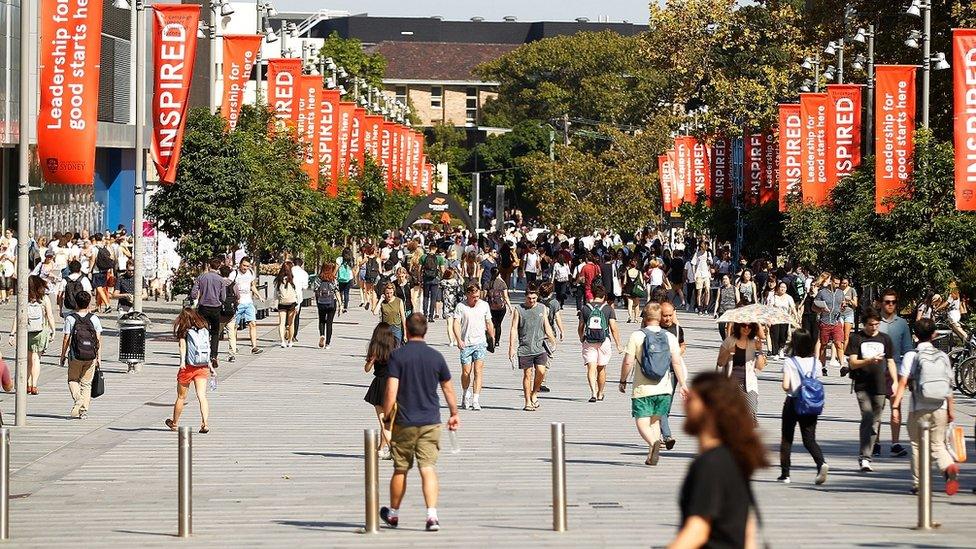Five things to watch on Australia's budget day
- Published

Scott Morrison will set out the government's pre-election stall with this budget
A lot is riding on Australian Treasurer Scott Morrison's economic plan, which doubles as the government's pitch to voters.
As the official announcement of an early election draws near, a resurgent opposition Labor party has been piling pressure on with populist policies.
It appears as if this budget is about two things: neutralising Labor's lines of attack for the election and playing up the government's economic management credentials.
This is aside from setting up Australia's economy for future prosperity and reducing a ballooning deficit. Here are five key things you should watch out for.
Raising revenue with borrowed ideas

Coal is one of Australia's most valuable exports
The end of the mining boom has left Australia with a deficit problem. Ratings agency Moody's said this month that Australia could lose its AAA credit rating if the government cut spending but failed to raise taxes.
The opposition has already boldly announced a number of policy measures aimed at raising revenue, including preventing multinational companies' tax avoidance, increasing the tobacco excise and cutting tax concessions for high-income earners saving for their retirement.
And all three measures will almost certainly be in the government's budget. Reports say Mr Morrison will reduce the amount of tax-deductible debt that multinational companies can load onto their local operations through so-called "thin capitalisation". The treasurer has also confirmed that the wealthy will pay more on their superannuation plans.

These are all relatively modest ideas. The government has taken an increase in the goods and services tax (GST) off the table.
It is also refusing to consider changes to negative gearing laws, which allows property investors to write off losses on private housing on tax. Ending negative gearing on existing dwellings is a key Labor policy.
Modest tax cuts
But while Labor plans to plunge additional revenue back into health and education, the government intends to use its new revenue to deliver a modest cut in the corporate tax rate of 30%. While this leaves Mr Morrison open to charges of supporting big business over ordinary Australians, the government says it will deliver productivity gains in the future.

Shadow Treasurer Chris Bowen
Workers earning around A$80,000 ($61,300; £42,000) per year can expect some tax relief as the threshold for entering the second-highest tax bracket, where earnings are taxed at 37 cents in the dollar, is pushed higher.
Mr Morrison appears to be sticking to his word that the budget will not be filled with sweeteners for voters. Instead the government is emphasising a message of fiscal responsibility and contrasting that with what it says is Labor's inclination to "tax and spend".
Health and education boosts
But even as it seeks to emphasise its economic credentials, the government wants to neutralise Labor's promised spending on health and education.
To that end, it's promising a A$5bn subsidised dental plan and an extra A$2.9bn for hospitals between 2017 and 2020. It will also provide an extra A$1.5bn for school funding. By way of comparison, the opposition is promising A$4.5bn in school funding.

The future of Australia's education system - both at school and university level - is an issue of concern to voters
This will be a key election battleground. Do voters trust Labor to deliver a solid economy along with increased social spending, or will they prefer the government's fiscally conservative approach?
Smart cities
Cities policy is a pet project of Prime Minister Malcolm Turnbull and the government plans to fund crucial infrastructure.
There will be A$5bn to pay for transport infrastructure, chiefly the Sydney Metro and Melbourne Metro rail projects. The fund will only partially pay for each project, with state governments to provide the rest of the cash.

Infrastructure investment is expected to be an important arm of the budget
Mr Turnbull has also announced a A$50m Smart Cities program which will look at issuing long-dated government bonds to pay for high-value infrastructure projects.
A return to surplus
Australia's budget has not been in surplus since 2007-08 and falls in commodity prices have left a gaping hole in the government's revenues. Australia is now carrying more than A$400bn in debt and this is growing.
The government is aiming to slow this ballooning debt over the next five or six years, returning the budget to surplus by around 2021. It may be wise not to put too much faith in that date as modelling from the treasury has predicted a rapid return to surplus more than once.
- Published3 May 2016

- Published19 April 2016
